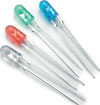

The fact that some LED components can be recycled is not just a positive aspect in environmental terms, it also results in lower disposal costs.
There is much less of an LED left at the end of its useful life than of other types of lamp.
LEDs offer many different savings: they do not have to be cleaned for example, nor - despite their 50 000 hour service lives - do they need maintaining. And maintenance can be very expensive in some cases, as the following example demonstrates: if a defective bulb causes a traffic light to fail, it is not merely a matter of the cost of a new light, but also of the time and effort for staff to come out and replace it, temporary traffic control by the police where appropriate and possibly additional required materials. The economic loss resulting from traffic congestion is a further factor.
Though the acquisition cost of an LED and the associated operating unit is higher than a conventional lamp, the savings over a period of years far outweigh the difference in initial outlay, because LEDs last in some cases 100 times longer than bulbs.
Higher price pays off
In order to deliver the light provided by conventional lamps, multiple LEDs are required. This does mean that the cost of lighting by LED is initially higher. It should be remembered, however, that the efficiency of LEDs is higher and so energy costs will be lower. A conventional 12 lm/W bulb uses three times more electricity than a white LED with a light output of 40 lm/W to attain the same level of brightness.
The story is similar with regard to the use of LEDs in vehicles: the additional electronics required, the higher numbers of LEDs and their higher unit costs mean that the purchase price is more. However, manufacturers are able to market LED-powered lights as a profitable optional extra, thereby also meeting the legal requirement to cut emissions.
Moreover, vehicle owners profit from reduced fuel consumption. The reason is that a generator driven by way of a belt by the engine generates the electrical energy needed for the vehicle. When more power is needed, the mechanical resistance of the engine increases, in turn increasing the fuel consumption. When LEDs are used less electrical energy is needed. The resultant reduction in power consumption is important to the automotive industry not only because it helps cut CO2 emissions in line with legal requirements. Government moves in Europe to make driving with daytime running lights mandatory at all times are also leading motor manufacturers increasingly to fit LEDs.
Half power is enough
According to the German Federal Highway Research Institute, daytime running on conventional bulb headlights results in an additional consumption of 0,052 litres per 100 km, while the additional consumption with LEDs is 0,02 l/100 km. In Germany, this would mean the annual additional fuel consumption resulting from permanent use of daytime running lights would be around 0,3% of the total with bulbs and 0,1% with LEDs. In other words: the total cost of cars driving permanently with their dipped beam headlights on (daytime running lights) resulting from the increase in fuel consumption in Germany would be 630 million Euro. Over the long term, daytime running lights using LEDs would cut that cost to 60 million Euro.
Another factor is that LEDs are so long-lasting that they would even outlive the vehicles in which they were fitted.
Red, orange and yellow age more slowly
Assuming that LEDs are operated within the limits specified by the manufacturers with regard to current and ambient temperature, and no environmental factors such as damp or chemicals lead to the premature destruction of the LED, the likelihood of a high-quality LED suffering a total failure over its lifetime is negligibly small. Failures of LED lamps usually result from defective or ageing solder points, while the LED itself remains operative.
It should, however, be borne in mind that there is a difference in lifetime between the various colours, as they are made by different technologies.
It can generally be assumed that LEDs in red, orange and yellow will age much less than green and blue - and thus also white - LEDs. In typical vehicle operation, red, yellow and orange LEDs attain service lifetimes of around 7000 hours. Operating at normal ambient temperature at 80% of the application-specific maximum permissible current, they attain around 10 000 hours, and at 50% around 100 000 hours. If white LEDs are operated at half the starting current, their lifetimes can be expected to double.

Double life can also be expected if the LED is operated at an ambient temperature of 30 Kelvins below the starting value. In contrast to bulbs, LEDs are still lighting at the end of their lives, though at 'time of death' their light intensity has fallen to 50% of its original level.
Consequently, the decision as to which light should be used in applications in which replacement is complex and costly, is easily made in favour of the LED.
Saving fuel with LEDs
A normal vehicle lighting system consumes 60 Watts of power. Lighting with LEDs requires just 6 W. This means 0,054 kWh of energy would be saved on a six-hour journey using daytime running lights. Considering that there are 54,9 million vehicles registered in Germany, driving a total of 528 billion kilometres a year, this would result in double-digit millions of Euro fuel cost saving.
| Tel: | +27 11 236 1900 |
| Email: | [email protected] |
| www: | www.ebv.com |
| Articles: | More information and articles about EBV Electrolink |

© Technews Publishing (Pty) Ltd | All Rights Reserved